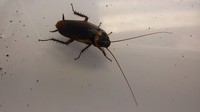Keeping out the roaches
The first time I raked the leaves in my yard after coming to Florida, I was shocked by the hundreds of roaches that scattered for cover. These insects are often reviled for the putrid smells they …
This item is available in full to subscribers.
Attention subscribers
To continue reading, you will need to either log in to your subscriber account, or purchase a new subscription.
If you are a current print subscriber, you can set up a free website account and connect your subscription to it by clicking here.
If you are a digital subscriber with an active, online-only subscription then you already have an account here. Just reset your password if you've not yet logged in to your account on this new site.
Otherwise, click here to view your options for subscribing.
Please log in to continueDon't have an ID?Print subscribersIf you're a print subscriber, but do not yet have an online account, click here to create one. Non-subscribersClick here to see your options for subscribing. Single day passYou also have the option of purchasing 24 hours of access, for $1.00. Click here to purchase a single day pass. |
Keeping out the roaches
The first time I raked the leaves in my yard after coming to Florida, I was shocked by the hundreds of roaches that scattered for cover. These insects are often reviled for the putrid smells they produce and the allergies they can trigger from their feces and shed body parts. However, most perform the service of recycling dead or dying plant and animal material and are only pests once they come in contact with people.
Do I have Cockroaches?
With 69 different species of cockroaches in the United States, they come in a range of sizes and colors, with the largest in Florida being the Florida Woods Roach, also known as the palmetto bug, being over two-inches long as an adult. Chances are that, in Florida, there is a species of roach somewhere on your property but that does not mean you have an issue.
To look for roaches in the home, check in sheltered dark areas such as under cabinets, beneath or behind molding, under furniture, and around water sources. In the yard they will congregate near mulch and leaf litter.
How do I prevent them from entering my home?
To prevent roaches in your home, it is a good idea to seal all possible entry points with caulk or sealant such as the foundation, around door and window molding, and any area where they might enter. It is also a good idea to keep mulch to a maximum thickness of one inch near the home and to keep plant material off the side of the home. You should also limit water sources around the yard and home, as roaches need water for survival and will enter the home looking for it in dry weather.
One of the best ways to prevent an infestation of indoor cockroaches is to limit their food sources. Recycle cardboard and do not keep it around the house and make sure to properly store and dispose of garbage. Also keep counters, appliances, dishes, and sinks clean, especially the strainer. Finally, make sure to seal up all groceries and pet food.
What if I find a cockroach?
One of the first parts of a proper pest management plan is to identify the roach and the scale of the infestation to see if it is an issue. One palmetto bug who wandered inside for a drink of water is not usually an issue but hundreds of german cockroaches living under your cabinets can definitely warrant a reaction. The UF/IFAS Clay County Extension Office can help to identify the species.
Integrated Pest Management practices should be utilized to manage any infestation of pests, including indoor and outdoor cockroaches. To manage an indoor infestation, you would first thoroughly clean and vacuum the area and apply baits or gels near entry points, as these are highly effective and limit your pesticide exposure. These should be monitored and replaced as needed until populations decrease. If populations are very high, a liquid pesticide can be used to knock down the population before using baits.
Outdoor cockroaches can be best managed by limiting entry into the home and by using granular control products within three feet of the home and around any areas in the yard where cockroaches may be, such as around railroad ties, stones, shrubs or leaf litter.
With any pesticide treatment, all products can be dangerous, so make sure to follow all directions on the label. If you need any further advice on cockroach management you can check the UF EDIS Fact Sheet on cockroaches found at https://edis.ifas.ufl.edu/pdffiles/IG/IG08200.pdf or contact the UF/IFAS Clay County Extension Office.
Want someone to answer a specific plant question for you? Go online to http://clay.ifas.ufl.edu and under the heading “Horticulture” (left hand side of page) left click on “Ask a Master Gardener” and a reply will be sent plus a hyperlink to the appropriate University of Florida Fact Sheets. Please send us a digital picture of the problem. To read past articles that might help you with seasonal problems and to learn about upcoming Extension Programming in our area go to our website at UF/IFAS Clay County Extension.











